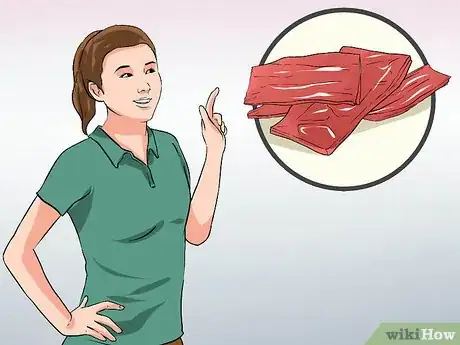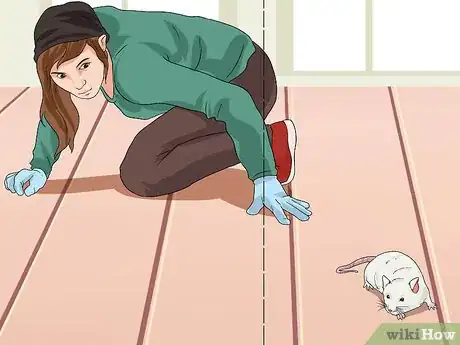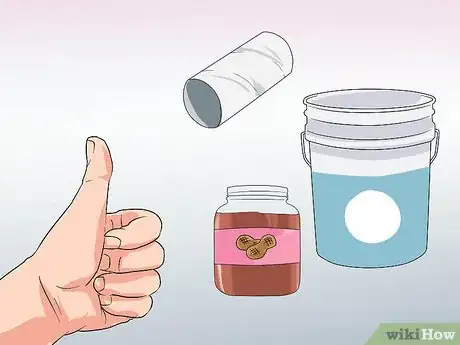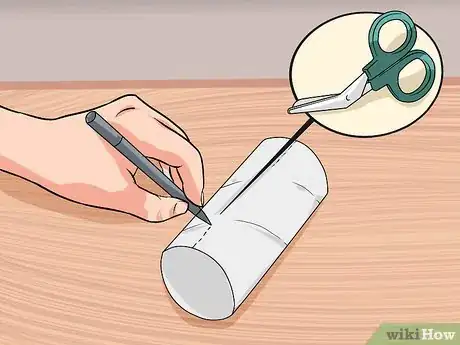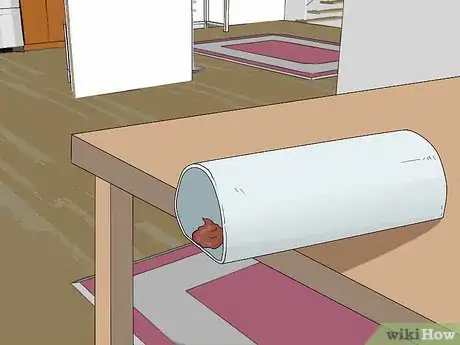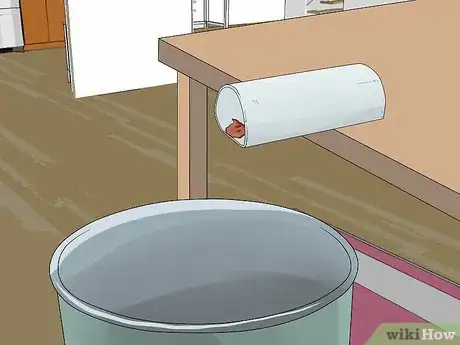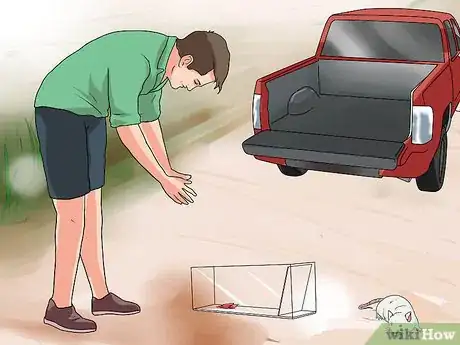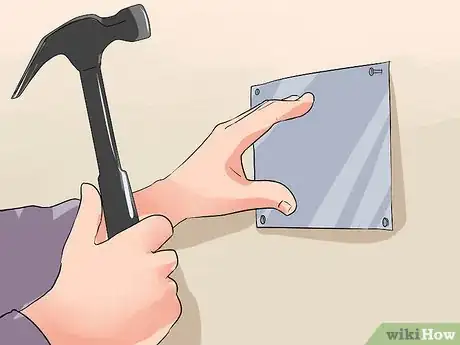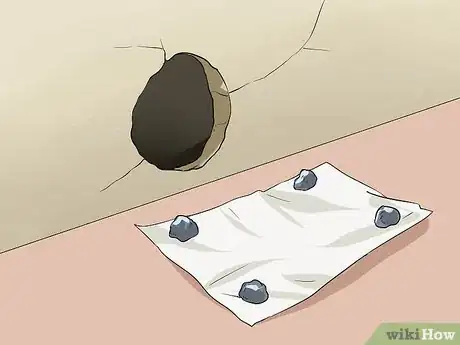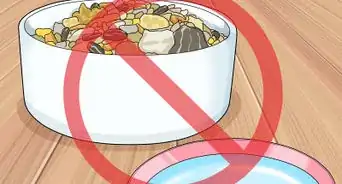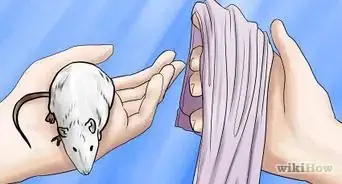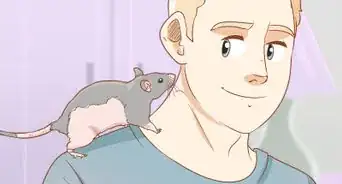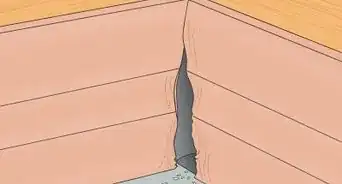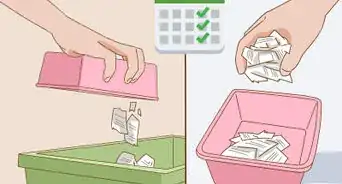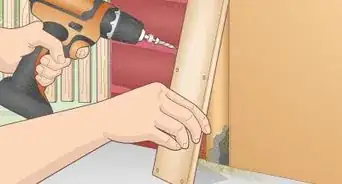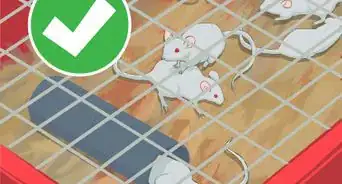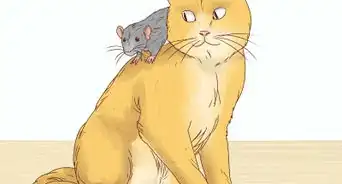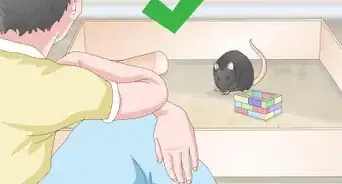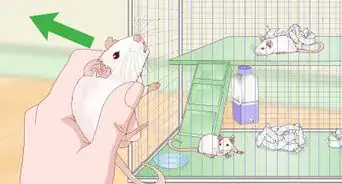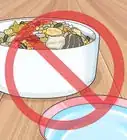This article was co-authored by Pippa Elliott, MRCVS. Dr. Elliott, BVMS, MRCVS is a veterinarian with over 30 years of experience in veterinary surgery and companion animal practice. She graduated from the University of Glasgow in 1987 with a degree in veterinary medicine and surgery. She has worked at the same animal clinic in her hometown for over 20 years.
wikiHow marks an article as reader-approved once it receives enough positive feedback. In this case, 93% of readers who voted found the article helpful, earning it our reader-approved status.
This article has been viewed 83,737 times.
Having a mouse inside of your apartment or house is not a serious problem, but many people dislike the act of killing the mouse, both for ethical reasons and because of the mess and smell of a dead mouse. Fortunately, you can catch a mouse without killing it, using readily available (and inexpensive) supplies.
Steps
Using Nonlethal Mouse Traps
-
1Research types of nonlethal trap. There are multiple types of inexpensive humane traps that will allow you to catch a mouse without harming it.[1] Popular types of nonlethal traps include:
- The Havahart Mouse Trap is a small steel cage with a trapdoor on either side. Mice are lured in by the smell of bait, and their weight triggers a mechanism which shuts the trap doors. These traps have plenty of room for the mouse inside, but can only trap one mouse at a time.
- The Smart Mouse Trap is made from transparent plastic. It has a single door; mice are lured in the door by the bait and, like the Havahart trap, their weight triggers a trap-door mechanism. This trap is recommended by many animal rights organizations.
- The Mice Cube trap is a long rectangular plastic box, with a one-way plastic door on one end. The bait is placed on the far side of the box and, once the mouse is inside, the door snaps shut behind it. This trap is the easiest of the three to use, but does not provide any ventilation to the trapped mouse.
- Once you decide which nonlethal trap to buy, check your local hardware store for availability.
-
2Bait your trap. The bait is the material that you will place inside of the mouse trap, in order for its scent to attract the mouse to your trap. If you have an inadequate bait, mice will not be drawn into your trap. Common types of mouse bait include substances that either put off a pungent odor, or that mice like to eat. Bait your trap using:
- Oatmeal or crackers.
- Peanut butter or bacon.
- Dry beef jerky.
Advertisement -
3Locate the mouse. You need to find specific locations which the mouse frequently moves through; these will be the most effective places for you to set your trap.[2]
- Listen along the walls for mice—they make a light scratching sound.
- If you’re lucky, you might see a mouse emerge from its
- Check along the floorboards; especially in dark, dry places.
- Look for mouse droppings, as these will indicate where the mouse is most active.
-
4Set your trap and wait. Mice are mostly active at night, so you may need to wait several hours (or even days) for the mouse to be caught.
- While the trap is set, keep small children and pets away from the vicinity.
Building your Own Humane Mouse Trap
-
1Collect the necessary supplies. Although there are multiple methods for constructing a nonlethal mouse trap, for this trap, you will need:
- A toilet-paper tube,
- A large 5-gallon bucket, and
- Mouse bait. For this trap, peanut butter works well.[3]
-
2Put two creases in the toilet-paper tube. This will let you set the tube down on a flat surface, without it rolling away.
- To make each crease, fold the toilet-paper tube firmly from front to back.
-
3Place a small spoonful of peanut butter on one end of the toilet-paper tube.[4]
- Smear the peanut butter on the flat bottom of the tube (in between the two creases you’ve made).
-
4Place the toilet-paper tube on the edge of a table or counter. This should be done near an area where the mouse has been seen, or where its droppings have been spotted.
- If there is no table or counter near the mouse’s area, move a table to a convenient location.
- The tube should be positioned so that the peanut-butter end is over the edge of the counter. It should be about halfway over the counter’s edge.
-
5Place the large 5-gallon bucket under the toilet-paper role. The bucket should be next to the table or counter.
- Although some plans for constructing this trap direct you to fill the bucket with a couple inches of water, you should avoid this step. Trapping the mouse in a water-filled bucket will drown the mouse.
-
6Wait for the mouse to fall into the trap. You may need to wait overnight for the mouse to come out and seek out the peanut butter.
- The mouse will walk across the table and through the toilet-paper role to eat the peanut butter. The role will fall off the edge of the counter and into the bucket, effectively trapping the mouse.
Releasing the Mouse
-
1Take the mouse several miles away from your own home. This way, there will be no risk of the mouse finding its way back.
- If you were to release the mouse in your yard or front lawn, it could easily sneak back in your house again.
-
2Release the mouse outdoors. Once you have successfully trapped the mouse (or it has fallen into your bucket trap), you need to move it outside of your home.
- As a courtesy to your neighbors, you should also avoid releasing the mouse near another house or residential center.
-
3Understand that the mouse’s life may still be at risk. Unfortunately, mice that were born indoors or have become used to living in a house are poorly suited to live in the outdoors.
- Mice that are trapped and released outside may not live long in nature.[5]
Preventing Mice from Returning
-
1Block holes or cracks in the foundation of your apartment. Even after you have successfully trapped a mouse and removed it from your home, you will want to make sure that other mice cannot get in your home.
- Have any cracks in concrete or your foundation repaired by a professional.
- Use steel wool (or copper wool) to block small or hard-to-reach holes.[6] You should use a caulk to secure the steel wool in place.
-
2Keep mice away with peppermint scent. Mice dislike the pungent odor of peppermint, and it will keep them from coming into areas that are heavily peppermint scented.[7]
- Buy peppermint extract from your local grocery store; then soak cotton balls in the peppermint oil. Lay the cotton balls around—or outside—your home in areas where you are concerned that mice may enter.
-
3Keep mice away with dryer sheets. Mice dislike the smell of dryer sheets, and will avoid an area in which dryer sheets have been placed.[8] Although dryer sheets are light-weight and can blow away if placed outside, they work well indoors. If you want to use dryer sheets outside, use a small stone or two to weight down the corners.
- You can also use dryer sheets to block holes in walls or concrete that mice may be sneaking in through.
- Since the scent will wear off eventually, switch out the dryer sheets for new ones every month.
-
4Clean up after meals and keep food sealed. Mice have acute senses of smell and, like many other invasive pests, usually come inside your home looking for a meal.
- Mice love to eat grains (including cereal and oatmeal), and will often gnaw through packaging to get at these foods. Keep grain products sealed in airtight containers.
References
- ↑ http://how-to-get-rid-of-mice.com/humane-mouse-traps/
- ↑ http://www.wildlifeanimalcontrol.com/mousecatch.html
- ↑ http://lifehacker.com/5451065/make-a-diy-no-kill-mousetrap-with-a-toilet-paper-roll
- ↑ http://lifehacker.com/5451065/make-a-diy-no-kill-mousetrap-with-a-toilet-paper-roll
- ↑ http://www.wildlifeanimalcontrol.com/mousecatch.html
- ↑ http://everydayroots.com/how-to-get-rid-of-mice
- ↑ http://everydayroots.com/how-to-get-rid-of-mice
- ↑ http://everydayroots.com/how-to-get-rid-of-mice
About This Article
To trap a mouse without harming it, first make a nonlethal trap by creasing a toilet-paper tube so it can sit flat without rolling away. Then, put your bait such as peanut butter, bacon, or crackers on one end of the tube, and place it on the edge of a table or counter where you've found droppings, heard scratching noises, or have seen the mouse. Position the trap to the baited end hangs over a large bucket or garbage can. When the mouse goes for the bait, it will fall in the bucket, allowing you to remove it from your house. For more tips from our Veterinary co-author, including how to prevent mice from returning, keep reading!

